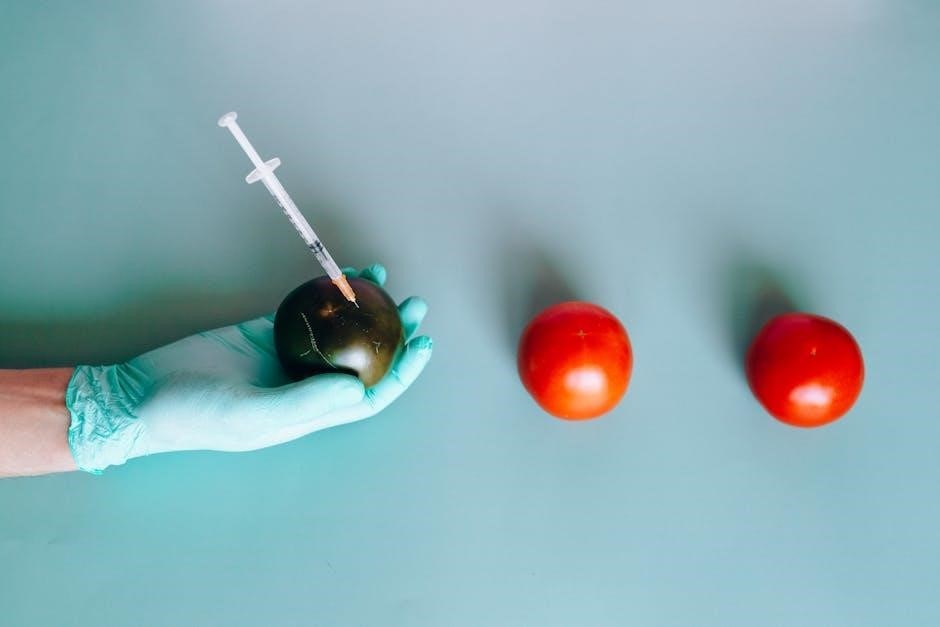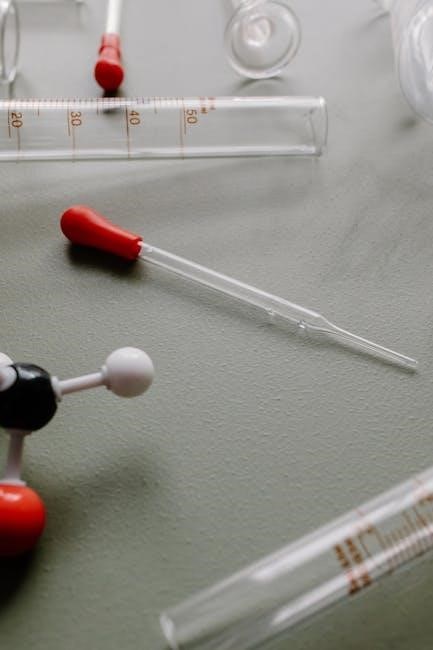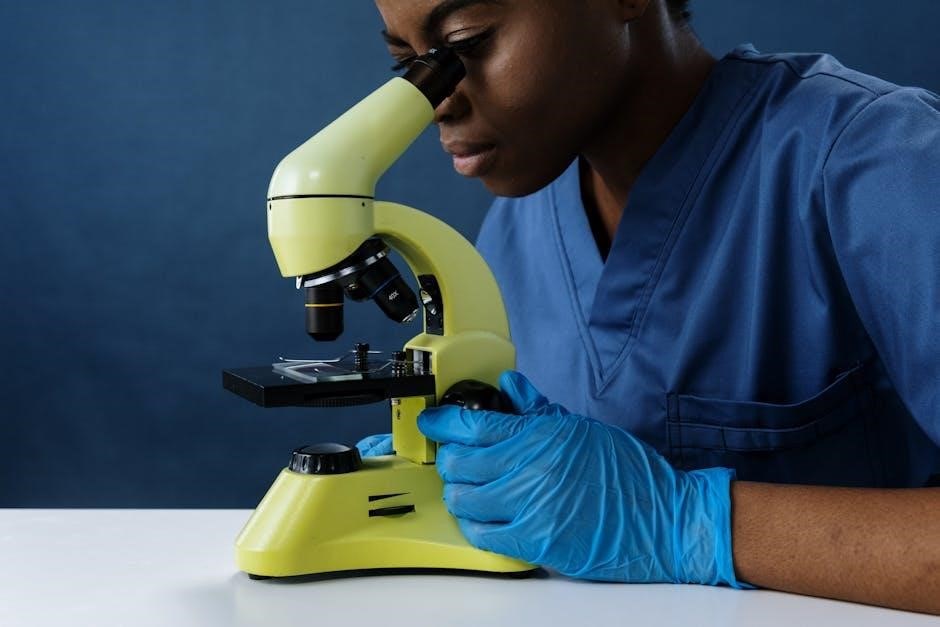Key Concepts and Overview

Unit 2 focuses on cell structure, transport, and function. Key topics include membrane structure, organelles, cellular transport mechanisms, energy conversion, and photosynthesis. Understanding these concepts is crucial for mastering AP Biology.
- Membrane structure and transport
- Cellular organelles and their functions
- Energy conversion in cells
- Photosynthesis and respiration
Use flashcards and practice tests to reinforce learning. Focus on critically analyzing processes and their interconnections.
AP Biology Unit 2 delves into the fundamental principles of cellular biology, focusing on structure, function, and transport. This unit lays the groundwork for understanding how cells operate, emphasizing the interconnectedness of cellular components. Key topics include the structure of biological membranes, types of cellular transport, and the roles of organelles such as the mitochondria, ribosomes, and endoplasmic reticulum. Students also explore energy conversion processes, including photosynthesis and cellular respiration, which are vital for life. Additionally, the unit introduces the cytoskeleton and its role in cell division, as well as signal transduction and cell communication mechanisms.
- Membrane structure and transport mechanisms (passive and active transport).
- Organelle functions and their importance in cellular processes.
- Energy conversion, including ATP production and photosynthesis;
- Cell division and the role of the cytoskeleton.
- Signal transduction and cell communication.
Mastering these concepts requires a strong understanding of how cells maintain homeostasis and respond to their environment. Utilize flashcards, practice tests, and detailed diagrams to reinforce learning. Focus on critical thinking and the ability to analyze complex biological processes.
Cell Structure and Function
Understanding cell structure and function is foundational to AP Biology. Cells are the basic units of life, and their organization and processes are essential for maintaining homeostasis. The cell membrane, a phospholipid bilayer, regulates what enters and leaves the cell, while the cytoplasm serves as the medium for metabolic activities. The nucleus houses genetic material, and organelles like mitochondria, ribosomes, and the endoplasmic reticulum perform specialized functions.
- The cell membrane follows the fluid mosaic model, allowing selective permeability.
- Organelles such as mitochondria (energy production) and ribosomes (protein synthesis) are critical for cellular function.
- The cytoskeleton provides structural support and aids in cell division and transport.
Key concepts include the role of the nucleus in DNA storage and transcription, as well as the importance of the cytoplasm in metabolic processes. Students should focus on understanding how these components interact to maintain cellular health and function. Use diagrams and practice questions to reinforce these concepts.
Membrane Structure and Transport
The cell membrane, composed of a phospholipid bilayer with embedded proteins, is a critical structure for cellular function. Its fluid mosaic model allows for dynamic movement of molecules, enabling processes like signaling and transport. Membrane transport is categorized into passive and active mechanisms;
- Passive Transport: Includes diffusion (e.g., oxygen entering cells) and osmosis (water movement), which require no energy.
- Active Transport: Requires energy (ATP) to move molecules against their concentration gradient, such as sodium-potassium pumps.
- Vesicle Transport: Larger molecules are moved via endocytosis (into the cell) or exocytosis (out of the cell).
Understanding membrane structure and transport is vital for topics like cellular homeostasis and signaling. Use diagrams to visualize how substances cross membranes and practice identifying transport types in different scenarios. Focus on how these processes maintain cellular balance and support overall organism function.
Cellular Organelles and Their Functions

Nucleus
The nucleus is the control center of the cell, housing DNA and regulating gene expression. It plays a central role in cell growth, metabolism, and reproduction.
Mitochondria

Mitochondria are the powerhouses of the cell, responsible for producing ATP through cellular respiration. They convert glucose into energy, essential for cellular functions.
Endoplasmic Reticulum (ER)
The ER is involved in protein synthesis and transport. The rough ER has ribosomes for protein assembly, while the smooth ER handles lipid synthesis and detoxification.
Ribosomes
Ribosomes are small organelles found throughout the cytoplasm, responsible for synthesizing proteins by translating mRNA into amino acid sequences.
Golgi Apparatus
The Golgi apparatus modifies, sorts, and packages proteins and lipids for distribution within or outside the cell, ensuring proper delivery of cellular products.
Lysosomes
Lysosomes contain digestive enzymes that break down and recycle cellular waste, foreign substances, and pathogens, maintaining cellular cleanliness.
Cytoplasm
Cytoplasm is the jelly-like substance where many metabolic processes occur. It houses organelles and allows for the movement of materials within the cell.
Understanding the roles of these organelles is essential for grasping cellular physiology. Use diagrams to visualize their interactions and functions within the cell.
Energy Conversion in Cells
Cells convert energy through processes like cellular respiration and photosynthesis. Cellular respiration breaks down glucose to produce ATP, while photosynthesis converts light energy into chemical energy.
Cellular Respiration
- Glycolysis: Occurs in the cytoplasm, breaking glucose into pyruvate, producing 2 ATP and NADH.
- Krebs Cycle: Takes place in the mitochondria, producing ATP, NADH, and FADH2 from pyruvate.
- Oxidative Phosphorylation: Generates ATP via electron transport chains, producing up to 32-34 ATP per glucose molecule.
Photosynthesis
- Light-Dependent Reactions: Occur in the thylakoid membranes, converting light energy into ATP and NADPH.
- Calvin Cycle: Uses ATP and NADPH to fix CO2 into glucose in the stroma of chloroplasts.
Understanding energy conversion is vital for AP Biology. Focus on the ATP yield from each stage of respiration and the light-dependent reactions in photosynthesis. Use diagrams to visualize these processes and their interconnections.

Photosynthesis and Respiration
Photosynthesis and cellular respiration are essential processes in biology, directly linked to energy conversion in cells. Photosynthesis occurs in chloroplasts and involves the conversion of light energy into chemical energy, while cellular respiration breaks down glucose to produce ATP.
Photosynthesis
- Light-Dependent Reactions: Occur in the thylakoid membranes, producing ATP and NADPH using light energy.
- Calvin Cycle: Takes place in the stroma, using ATP and NADPH to fix CO2 into glucose.
- Key equation: 6 CO2 + 6 H2O + light energy → C6H12O6 + 6 O2.
Cellular Respiration
- Glycolysis: Breaks down glucose into pyruvate in the cytoplasm, producing 2 ATP and NADH.
- Krebs Cycle: Occurs in the mitochondria, producing ATP, NADH, and FADH2 from pyruvate.
- Oxidative Phosphorylation: Generates ATP via the electron transport chain, producing up to 32-34 ATP per glucose molecule.
- Key equation: C6H12O6 + 6 O2 → 6 CO2 + 6 H2O + ATP.
Understanding the interplay between photosynthesis and respiration is critical. Focus on the equations, ATP yields, and locations of each process. Use diagrams to visualize these pathways and their connections to energy conversion in cells.
The Cytoskeleton and Cell Division
The cytoskeleton is a dynamic network of filaments that provides structural support, shape, and enables cell movement and division. It consists of three main components: microtubules, microfilaments, and intermediate filaments. Microtubules are involved in maintaining cell shape and organizing organelles, while microfilaments play a role in muscle contraction and cell motility. Intermediate filaments provide mechanical stability.
Cell Division
Cell division is essential for growth, repair, and reproduction. Mitosis results in two genetically identical diploid daughter cells, while meiosis produces four non-identical haploid gametes, introducing genetic diversity.
Stages of Mitosis
- Prophase: Chromosomes condense, and the spindle forms.
- Metaphase: Chromosomes align at the center.
- Anaphase: Sister chromatids separate.
- Telophase: Chromosomes uncoil, and nuclei form.
- Cytokinesis: Cytoplasm divides, completing cell division.
Role of the Cytoskeleton
The cytoskeleton is crucial in cell division, particularly in spindle fiber formation and chromosome separation. Understanding its role is vital for comprehending cellular processes.
Signal Transduction and Cell Communication
Signal transduction and cell communication are critical processes that allow cells to respond to external signals, maintaining homeostasis and enabling coordinated cellular activities. Signal transduction involves the conversion of a signal from one form to another, often amplifying the response. Cells communicate through signaling molecules, such as hormones, neurotransmitters, and growth factors, which bind to specific receptors on target cells.
Key Mechanisms
- Receptor Types: Cells use membrane-bound receptors (e.g., G-protein coupled receptors) or intracellular receptors (e.g., steroid hormone receptors) to detect signals.
- Signaling Pathways: Signals are transmitted through cascades, such as the MAP kinase pathway, amplifying the response.
- Second Messengers: Molecules like cAMP and calcium ions act as intermediaries, relaying signals within the cell.
Types of Signaling
Signaling can be autocrine (affecting the same cell), paracrine (local cells), endocrine (distant cells via blood), or direct (gap junctions). Each type ensures precise communication, enabling processes like immune responses, growth regulation, and metabolic control.
Regulation and Importance
Signal transduction is tightly regulated to prevent overactivation or suppression of cellular responses. Dysregulation can lead to diseases, including cancer. Understanding this process is vital for appreciating cellular behavior and its role in overall organism function.
Study Tips and Practice Questions
Mastering AP Biology Unit 2 requires a strategic approach to studying and practicing. Start by focusing on key concepts, such as cell structure, transport, and energy conversion. Use active recall by creating flashcards for terms like “passive transport” or “photosynthesis stages.” Apps like Quizlet can help reinforce memorization.
Effective Study Strategies
- Practice Past Exams: Complete official practice questions and timed sections to simulate test conditions. Analyze mistakes to identify weak areas.
- Focus on Processes: Understand mechanisms like cellular respiration or signal transduction rather than just memorizing facts. Diagrams and flowcharts are excellent tools.
- Review Key Labs: Labs on cell structure and transport are often tested. Review procedures and outcomes to apply concepts to questions.
Practice Question Tips
Start with basic multiple-choice questions to build confidence, then tackle challenging free-response questions. Use resources like College Board’s study guides or Khan Academy for additional practice. Pay attention to question trends, such as energy conversion or membrane structure.
Stay organized, review consistently, and seek help when needed. With dedicated practice, you’ll be well-prepared for Unit 2 and beyond!
